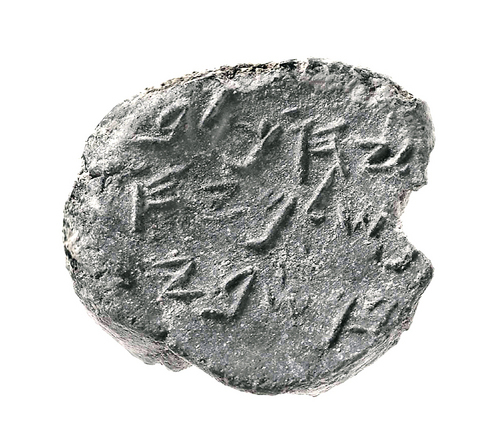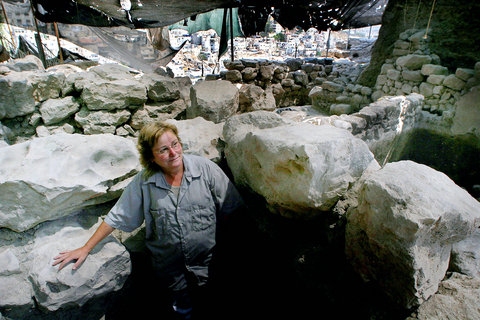An Israeli archaeologist says she has uncovered in East Jerusalem what may be the fabled palace of the biblical King David. Her work has been sponsored by a conservative Israeli research institute and financed by an American Jewish investment banker who would like to prove that Jerusalem was indeed the capital of the Jewish kingdom described in the Bible.
Other scholars are skeptical that the foundation walls discovered by the archaeologist, Eilat Mazar, are David's palace. But they acknowledge that what she has uncovered is rare and important: a major public building from around the 10th century BC, with pottery shards that date to the time of David and Solomon and a government seal of an official mentioned in the book of Jeremiah. The discovery is likely to be a new salvo in a major dispute in biblical archaeology: whether the kingdom of David and Samuel was of some historical magnitude, or whether the men were more like small tribal chieftains, reigning over another dusty hilltop.
The find will also be used in the broad political battle over Jerusalem -- whether the Jews have their origins here and thus have some special hold on the place, or whether, as many Palestinians have said, including the late Yasser Arafat, the idea of a Jewish origin in Jerusalem is a myth used to justify conquest and occupation. Hani Nur el-Din, a Palestinian professor of archaeology at Al Quds University, said he and his colleagues considered biblical archaeology an effort by Israelis "to fit historical evidence into a biblical context."

He added, "The link between the historical evidence and the biblical narration, written much later, is largely missing. There's a kind of fiction about the 10th century. They try to link whatever they find to the biblical narration. They have a button, and they want to make a suit out of it."
Even Israeli archaeologists are not so sure that Mazar has found the palace -- the house that Hiram, king of Tyre, built for the victorious king, at least as Samuel 2:5 describes it. It may also be the Fortress of Zion that David conquered from the Jebusites, who ruled Jerusalem before him, or some other structure about which the Bible is silent. Either way, they are impressed by its likely importance.
"This is a very significant discovery, given that Jerusalem as the capital of the united kingdom is very much unknown," said Gabriel Barkay, an archaeologist from Bar-Ilan University.

PHOTO: NY TIMES
"This is one of the first greetings we have from the Jerusalem of David and Solomon, a period which has played a kind of hide-and-seek with archaeologists for the last century."
Based on the Bible and a century of archaeology in this spot, Mazar, 48, speculated that a famous stepped-stone structure excavated previously was part of the fortress David conquered, and that his palace would have been built just outside the original walls of the cramped city, on the way to what his son, Solomon, built as the Temple Mount.
"When the Philistines came to fight, the Bible said that David went down from his house to the fortress," she said, her eyes bright. "I wondered, down from where? Presumably from where he lived, his palace."
"So I said, maybe there's something here," she added, referring to East Jerusalem. David's palace was the topic of a last conversation Mazar had with her grandfather, Benjamin Mazar, a famous archaeologist who helped to train her and who died 10 years ago. Five months ago, with money and permission from the Ir David Foundation, which controls the site (and supports Jews moving into East Jerusalem), she finally began to dig. Amihai Mazar, a professor of archaeology at Hebrew University, calls the find "something of a miracle."
He says he believes that the building may be the Fortress of Zion that David is said to have conquered, which he renamed the City of David.
"What she found is fascinating, whatever it is," he said. Amihai Mazar is Eilat Mazar's second cousin, but he has his own reputation to protect. Archaeologists debate "to what extent Jerusalem was an important city or even a city in the time of David and Samuel," he said.
"Some believe it was tiny and the kingdom unimportant."
The site of ancient Jerusalem, stuck between two valleys on a ridge south of the Temple Mount, is very small, less than 10 acres. Israel Finkelstein, another renowned archaeologist, has suggested that without significant evidence, Jerusalem in this period was "perhaps not more than a typical hill-country village."
In his book, The Bible Unearthed, Finkelstein writes with Neil Silberman, "Not only was any sign of monumental architecture missing, but so were even simple pottery shards."
The building can be reasonably dated by the pottery found above and below it. Mazar found on the bedrock a large floor of crushed limestone, indicating a large public space. The floor and fill above it contain pottery from Iron Age I of the 12th to 11th centuries BC, just before David conquered Jerusalem. Above that, Mazar found the foundations for this monumental building, with large boulders for walls that are more than 1.8m thick and extend at least 30m. In one corner was pottery from Iron Age 2, the 10th to 9th centuries, roughly the time of the united kingdom. Unfortunately, Amihai Mazar said, she found no floor. It is clear the building was constructed after the pottery underneath it, but less clear exactly how much later.
The archaeological debate is also partly a debate over the roots of Zionism and the effort to find Jewish origins deep in the land. Eilat Mazar's latest dig, which has cost about US$500,000, has been sponsored by Roger Hertog, a New York financier who is vice chairman of Alliance Capital Management. Hertog, who owns a piece of The New York Sun and The New Republic, is also chairman of the board of the Shalem Center in Jerusalem, where Mazar is a senior fellow.
The Shalem Center was founded as Israel's first "neoconservative think-tank," said William Kristol, who is also on the board, in an effort to give the Israeli right a better foundation in history, economics, archaeology and other topics. Hertog calls his investment in Mazar "venture philanthropy -- you have the opportunity for intellectual speculation, to fund something that is a work of great consequence." He said he hoped to show "that the Bible reflects Jewish history."
Mazar continues to dig, but right now, three families are living in houses where she would most like to explore. One family is Muslim, one Christian and one Jewish.

April 14 to April 20 In March 1947, Sising Katadrepan urged the government to drop the “high mountain people” (高山族) designation for Indigenous Taiwanese and refer to them as “Taiwan people” (台灣族). He considered the term derogatory, arguing that it made them sound like animals. The Taiwan Provincial Government agreed to stop using the term, stating that Indigenous Taiwanese suffered all sorts of discrimination and oppression under the Japanese and were forced to live in the mountains as outsiders to society. Now, under the new regime, they would be seen as equals, thus they should be henceforth

With over 100 works on display, this is Louise Bourgeois’ first solo show in Taiwan. Visitors are invited to traverse her world of love and hate, vengeance and acceptance, trauma and reconciliation. Dominating the entrance, the nine-foot-tall Crouching Spider (2003) greets visitors. The creature looms behind the glass facade, symbolic protector and gatekeeper to the intimate journey ahead. Bourgeois, best known for her giant spider sculptures, is one of the most influential artist of the twentieth century. Blending vulnerability and defiance through themes of sexuality, trauma and identity, her work reshaped the landscape of contemporary art with fearless honesty. “People are influenced by

Last week, the the National Immigration Agency (NIA) told the legislature that more than 10,000 naturalized Taiwanese citizens from the People’s Republic of China (PRC) risked having their citizenship revoked if they failed to provide proof that they had renounced their Chinese household registration within the next three months. Renunciation is required under the Act Governing Relations Between the People of the Taiwan Area and the Mainland Area (臺灣地區與大陸地區人民關係條例), as amended in 2004, though it was only a legal requirement after 2000. Prior to that, it had been only an administrative requirement since the Nationality Act (國籍法) was established in

The remains of this Japanese-era trail designed to protect the camphor industry make for a scenic day-hike, a fascinating overnight hike or a challenging multi-day adventure Maolin District (茂林) in Kaohsiung is well known for beautiful roadside scenery, waterfalls, the annual butterfly migration and indigenous culture. A lesser known but worthwhile destination here lies along the very top of the valley: the Liugui Security Path (六龜警備道). This relic of the Japanese era once isolated the Maolin valley from the outside world but now serves to draw tourists in. The path originally ran for about 50km, but not all of this trail is still easily walkable. The nicest section for a simple day hike is the heavily trafficked southern section above Maolin and Wanshan (萬山) villages. Remains of